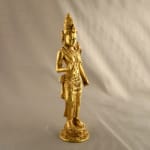Indonesian Gold Sculpture of standing Tara or Prajnaparamita, 900 CE - 1300 CE
Gold
18.4 x 5.1 cm
7 1/4 x 2 in
7 1/4 x 2 in
CK.0165
Further images
Like much of Southeast Asia, the island of Bali (today a part of the archipelago nation of Indonesia) has historically been highly influenced by Indian civilization. The religions of Hinduism...
Like much of Southeast Asia, the island of Bali (today a part of the archipelago nation of Indonesia) has historically been highly influenced by Indian civilization. The religions of Hinduism and Buddhism, both originating from the subcontinent, were the vehicles through which Indian culture spread across the greater archipelago region.
Prajnaparamita is considered as the Mother of all the Buddhas, the Great Mother, since Buddhahood roots from prajna(wisdom)-paramita(perfection). She is seen to be the embodiment of transcendent wisdom. In this figure, Prajnaparamita is depicted with fine silk clothes and a crown of gold embedded with jewels all symbols of royalty. Standing elegantly, she holds a lotus blossom at her left while her right hands form the prajnaparamita mudra. Since Tara and Prajnaparamita shares a lot of common traits and iconographic features, this figure could also be interpreted as Tara.
Prajnaparamita is considered as the Mother of all the Buddhas, the Great Mother, since Buddhahood roots from prajna(wisdom)-paramita(perfection). She is seen to be the embodiment of transcendent wisdom. In this figure, Prajnaparamita is depicted with fine silk clothes and a crown of gold embedded with jewels all symbols of royalty. Standing elegantly, she holds a lotus blossom at her left while her right hands form the prajnaparamita mudra. Since Tara and Prajnaparamita shares a lot of common traits and iconographic features, this figure could also be interpreted as Tara.





